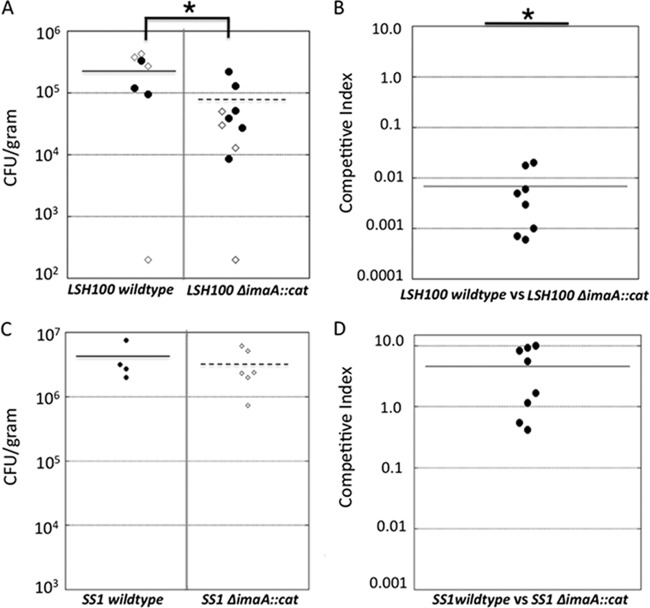Fig 2.
(A) The H. pylori LSH100 ΔimaA::cat mutant colonizes mice at levels significantly lower than those of the wild-type H. pylori LSH100 parent. Oral single-strain infection studies with the wild-type H. pylori or ΔimaA::cat mutant were carried out using male FVB/N mice. Infections persisted for 2 or 3 weeks. Single-strain infections were conducted with 7 mice for the wild-type strain and with 10 mice for the ΔimaA::cat mutant. Each circle represents the value for one infected mouse, derived from independent 2-week (open circles) or 3-week (filled circles) infections, and the solid or broken line represents the mean for the group of mice. The values between the two groups of mice in panel A were significantly different (P = 0.01 by Student's t test) and are indicated by the bracket and asterisk. (B) The H. pylori LSH100 ΔimaA::cat mutant is outcompeted by the wild-type strain in a coinfection colonization assay. Each point represents the competitive index for one mouse stomach for eight mice in two independent infections. The competitive index is a ratio and is calculated as follows: (mutant output/wild-type output)/(mutant input/wild-type input). The values were significantly different (P < 0.001 by Student's t test) compared to a hypothetical strain with no defect (competitive index [CI] of 1). (C) The H. pylori SS1 ΔimaA::cat mutant colonizes mice at levels that are comparable to those of wild-type H. pylori SS1. These infections persisted for 2 weeks, with four mice for the wild-type strain and six mice for the ΔimaA::cat mutant strain. (D) The H. pylori SS1 ΔimaA::cat mutant is not outcompeted for mouse colonization in a coinfection with wild-type H. pylori in two independent infections of eight mice.

